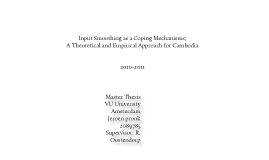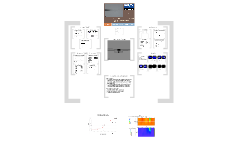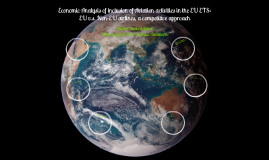Master Thesis Presentation
Transcript: Circuit Model Commutation Relations Matlab Capacitor WHAT WE DID : We derived a model for the time evolution of the two-level qubit eigenstates as a function of qubit eigenfrequency, temperature, qubit relaxation and coherence rates as well as input driving field. We calculated numerical graphs of the transmission and reflection showing results comparable to experimental observation, taking all approximations in consideration. WHAT NEEDS TO BE DONE : extend the model to a three-level system include other frequencies in the analysis explain the triangular structure Full Circuit Model Theoretical Model Derivation QUANTUM OPTICS Fundamental interaction between light and matter Fluoresence spectra : detect molecules, ... ARTIFICIAL ATOM Allows study of strong coupling regime Possibility of coupling atom to a single mode RELATED WORK O. Astafiev, A. M. Zagoskin, A. A. Abdumalikov Jr., Yu. A. Pashkin, T. Yamamoto, K. Inomata, Y. Nakamura, J. S. Tsai, "Resonance Fluoresence of a Single Artificial Atom," Science, Vol. 327, February 2010 A. A. Abdumalikov, Jr. , O. Astafiev, A. M. Zagoskin, Yu. A. Pashkin, Y. Nakamura, J. -S. Tsai, "Electromagnetically Induced Transparency on a Single Artificial Atom," PRL 104, May 2010 Triangular feature : numerical issue or physical ? Power conservation ? Lagrangian Conclusions and Outlook Legendre Transformation Introduction Cooper Pair Box Josephson Junction Full Circuit t_min = 0; t_max = 5e-7; tspan = linspace(t_min, t_max, 2500)'; sigma0 = [1 0 0 0]; options = odeset('AbsTol', 1e-30, 'RelTol', 1e-8); [T, sigma] = ode113(@diffsigma, tspan, sigma0, options); Heisenberg Eqs. of Motion Master Equation Results Hamiltonian Inductor Rewriting Output Field Up to 50% power lost ? --> contained in other frequencies Triangular structure still present in high precision plot ... Qubit energyspectrum Experimental Setup Perfect reflection in resonance at low incoming power Qubit = sharp frequency filter Filter width ~ 1 / relaxation time Perfect reflection in resonance at low incoming power Low amplitude = low incoming-photon rate If (incoming-photon rate << relaxation rate) --> perfect reflection Perfect reflection at -150 dBm No instant reflection because of blockwave shape of incoming voltage signal --> no single frequency 1D Waveguide

















